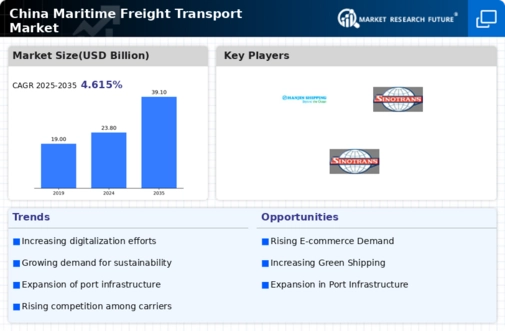The maritime freight-transport market in China is characterized by a competitive landscape that is both dynamic and multifaceted. Key growth drivers include the increasing demand for efficient logistics solutions, the expansion of e-commerce, and the ongoing investments in port infrastructure. Major players such as COSCO Shipping (CN), A.P. Moller - Maersk (DK), and CMA CGM (FR) are strategically positioned to leverage these trends. COSCO Shipping (CN) focuses on enhancing its fleet capabilities and expanding its global reach, while A.P. Moller - Maersk (DK) emphasizes digital transformation and sustainability initiatives. CMA CGM (FR) is actively pursuing mergers and acquisitions to bolster its market presence, indicating a trend towards consolidation in the sector. Collectively, these strategies shape a competitive environment that is increasingly reliant on innovation and operational efficiency.
Key business tactics within the maritime freight-transport market include supply chain optimization and localized service offerings. The market structure appears moderately fragmented, with a mix of large multinational corporations and regional players. The influence of key players is substantial, as they drive technological advancements and set industry standards. This competitive structure fosters an environment where collaboration and strategic partnerships are essential for maintaining market share and enhancing service delivery.
In October 2025, COSCO Shipping (CN) announced the launch of a new digital platform aimed at streamlining logistics operations and improving customer engagement. This initiative is significant as it reflects the company's commitment to digitalization, which is increasingly vital in meeting customer expectations for transparency and efficiency. By investing in technology, COSCO Shipping (CN) positions itself as a leader in the digital transformation of the maritime sector.
In September 2025, A.P. Moller - Maersk (DK) unveiled its ambitious plan to achieve carbon neutrality by 2040, which includes investing in alternative fuels and energy-efficient vessels. This strategic move underscores the growing importance of sustainability in the maritime freight-transport market. As environmental regulations tighten, Maersk's proactive approach may enhance its competitive edge and appeal to environmentally conscious customers.
In August 2025, CMA CGM (FR) completed the acquisition of a regional shipping line, thereby expanding its operational footprint in Asia. This acquisition is indicative of the ongoing trend towards consolidation in the industry, allowing CMA CGM (FR) to enhance its service offerings and improve operational efficiencies. Such strategic actions are likely to reshape competitive dynamics, as companies seek to strengthen their market positions through scale and synergies.
As of November 2025, current competitive trends in the maritime freight-transport market include a pronounced focus on digitalization, sustainability, and the integration of artificial intelligence (AI) into operations. Strategic alliances are increasingly shaping the landscape, as companies collaborate to enhance service capabilities and address shared challenges. Looking ahead, competitive differentiation is expected to evolve, with a shift from price-based competition to a focus on innovation, technology, and supply chain reliability. This transition may redefine success in the maritime freight-transport market, emphasizing the need for agility and responsiveness to changing market demands.














Leave a Comment